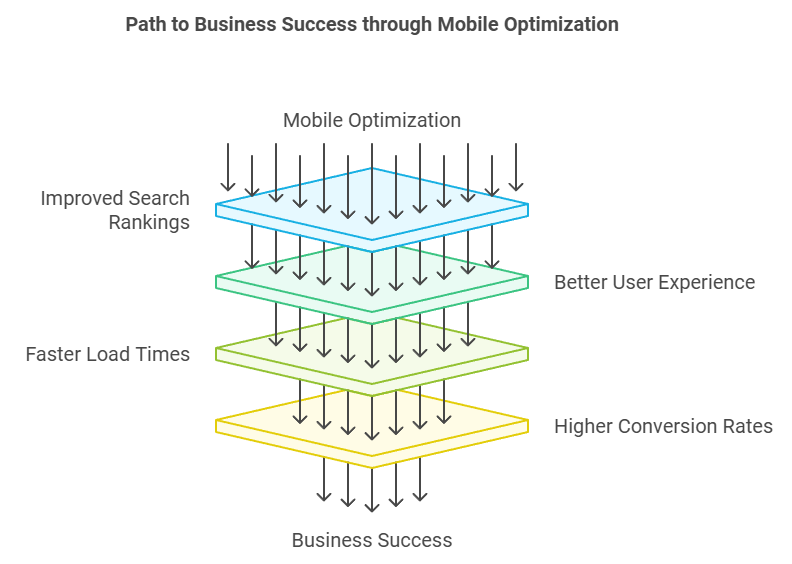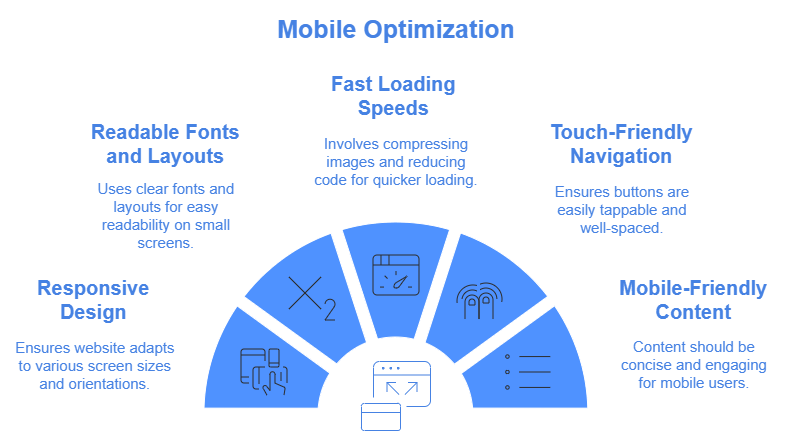Mobile optimization is no longer optional; it is a necessity. With more people relying on mobile devices for browsing and shopping, businesses must adapt their websites to be mobile-friendly. Mobile optimization ensures your site performs well on smartphones and tablets, improving search engine rankings and providing a smooth user experience. Let us dive deeper into why mobile optimization is critical for achieving SEO success.
Table of Contents
ToggleWhat Is Mobile Optimization?
Mobile optimization is the process of tailoring your website so it functions seamlessly on mobile devices. It involves adjusting design, layout, and content for smaller screens, ensuring everything is easy to read and navigate. Mobile optimization also ensures quick load times and proper functionality across different devices.
A mobile-optimized site improves how users interact with your content and ensures search engines rank your site favorably. Search engines like Google prioritize mobile-friendly websites, meaning a lack of optimization could cost you visibility and traffic.
The Shift Toward Mobile Usage

Mobile Devices Are Dominating Internet Traffic
Statistics show that mobile devices now account for over half of global web traffic. Whether users are shopping, reading, or researching, they rely heavily on smartphones. A desktop-only strategy can alienate a massive portion of your audience.
Changing User Behavior
Mobile users expect fast and smooth experiences. If your website is not optimized for mobile, visitors are likely to leave and search for alternatives. High bounce rates negatively impact your rankings.
Mobile-First Indexing by Google
In recent years, Google introduced mobile-first indexing. This means that Google primarily uses the mobile version of a site for ranking and indexing. If your site is not mobile-friendly, you are likely to fall behind competitors in search results.
Why Mobile Optimization Is Key for SEO

Mobile Optimization Can Improve Search Engine Rankings
Search engines reward mobile-friendly websites with better rankings. A poorly optimized site can sink in the rankings, making it harder for potential visitors to find your business.
Better User Experience
A mobile-optimized site ensures visitors can easily navigate and interact with your content. Smooth navigation reduces frustration and increases the likelihood of users staying on your site longer, signaling to search engines that your content is valuable.
Faster Load Times
Mobile users have little patience for slow-loading pages. Websites that load within three seconds retain more visitors. Speed is a direct ranking factor, and mobile optimization addresses this by improving load times.
Higher Conversion Rates
An accessible mobile site makes it easier for users to take action, whether it is making a purchase, signing up for a newsletter, or contacting your business. Higher conversions contribute to overall business success.
Key Elements of Mobile Optimization

Responsive Design
Responsive design ensures your site adapts to different screen sizes and orientations. It is the foundation of any mobile optimization strategy, guaranteeing content looks and functions well on all devices.
Readable Fonts and Layouts
Using clear fonts and layouts that are easy to read on smaller screens is crucial. Users should not have to zoom in or scroll horizontally to view your content.
Fast Loading Speeds
Compressing images, reducing unnecessary code, and enabling browser caching are just a few ways to speed up your website for mobile users.
Touch-Friendly Navigation
Ensure buttons and links are large enough to tap easily. Avoid placing elements too close together, as this can frustrate users.
Mobile-Friendly Content
Content should be concise, engaging, and easy to scan. Use bullet points and short paragraphs to keep mobile users engaged.
Common Mistakes in Mobile Optimization
Ignoring Page Speed
One of the biggest mistakes is neglecting to prioritize page speed. Mobile users are more likely to leave slow websites, which can hurt your rankings and user retention.
Not Testing Across Devices
Failing to test your site on various devices can lead to compatibility issues. Always check how your website appears on different screen sizes.
Overloading Pages with Content
While content is important, too much can overwhelm mobile users. Simplify your design and focus on delivering the most important information.
Forgetting About Pop-Ups
Intrusive pop-ups can frustrate mobile users and lead to higher bounce rates. Use pop-ups sparingly and ensure they are easy to close.
Steps to Achieve Mobile Optimization
Analyze Your Current Site
Start by assessing how mobile-friendly your website is. Tools like Google’s Mobile-Friendly Test can highlight areas that need improvement.
Prioritize Mobile-First Design
Design your site with mobile users in mind first, then adapt it for desktops. This ensures mobile visitors have the best experience possible.
Compress Media Files
Large images and videos can slow down your site. Compress these files without sacrificing quality to improve loading speeds.
Use Accelerated Mobile Pages (AMP)
AMP is a framework that creates lightweight pages for mobile users. It enhances speed and performance, helping you retain visitors.
Focus on Accessibility
Your site should be usable by everyone, including those with disabilities. Use alt text for images, ensure proper color contrast, and design easy-to-read content.
The Role of Mobile Optimization in User Retention
Building Trust with Users
A mobile-friendly website builds trust. When users can easily navigate and find what they need, they are more likely to return and recommend your site to others.
Reducing Bounce Rates
Bounce rates reflect the percentage of visitors who leave your site without taking any action. Mobile optimization keeps visitors engaged, reducing bounce rates and boosting your SEO.
Increasing Time Spent on Site
When users enjoy their browsing experience, they spend more time exploring your content. This signals to search engines that your site is valuable and informative.
Tools and Resources to Improve Mobile Optimization
- Google’s Mobile-Friendly Test: A simple tool to identify mobile optimization issues.
- PageSpeed Insights: Provides insights into site performance and suggests improvements.
- GTmetrix: Analyzes page speed and performance in detail.
- BrowserStack: Allows you to test your site on different devices and browsers.
How Mobile Optimization Impacts Business Growth

Expanding Your Audience
With more users relying on mobile devices, a mobile-optimized site opens doors to a broader audience.
Strengthening Your Online Presence
Search engines favor mobile-friendly sites, improving your visibility and credibility.
Driving Revenue
Higher conversion rates from mobile users lead to increased sales and revenue, directly benefiting your bottom line.
Future of Mobile Optimization
The demand for mobile-friendly websites will only grow. As technology evolves, businesses that invest in mobile optimization now will stay ahead of the curve. Keeping up with mobile trends ensures your site remains competitive and relevant.
Conclusion: Mobile Optimization for SEO
Mobile optimization is essential for SEO success. By making your site mobile-friendly, you improve search engine rankings, enhance user experience, and drive business growth. With mobile devices shaping how people browse and shop online, there is no better time to prioritize mobile optimization. Invest in these strategies today to secure long-term success for your website.
Mobile Optimization FAQs
1. What is mobile-first indexing?
Mobile-first indexing means Google primarily uses the mobile version of a website for ranking and indexing.
2. How does mobile optimization affect SEO rankings?
Mobile optimization improves user experience, speeds up load times, and aligns with Google’s ranking criteria, boosting SEO.
3. Can I test my site for mobile optimization?
Yes, tools like Google’s Mobile-Friendly Test and PageSpeed Insights can help identify areas for improvement.
4. What is the difference between responsive and mobile-friendly design?
Responsive design adapts to any screen size, while mobile-friendly design specifically focuses on usability on smaller devices.
5. How often should I update my mobile optimization strategy?
Regular updates are crucial. Analyze your site’s performance frequently to stay aligned with changing mobile trends.








